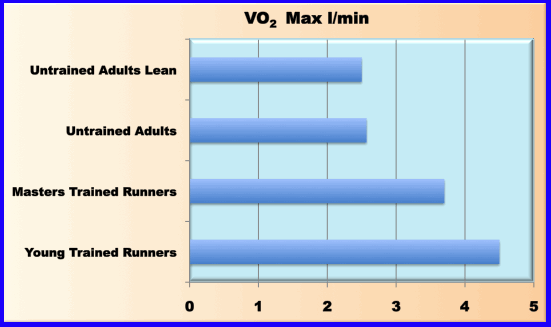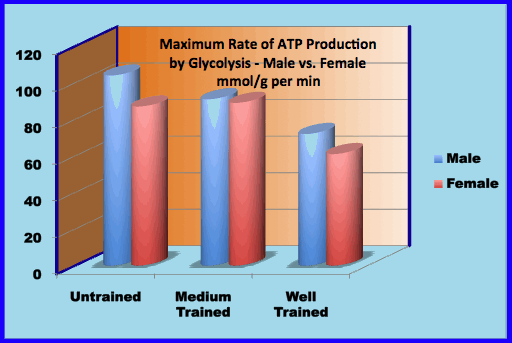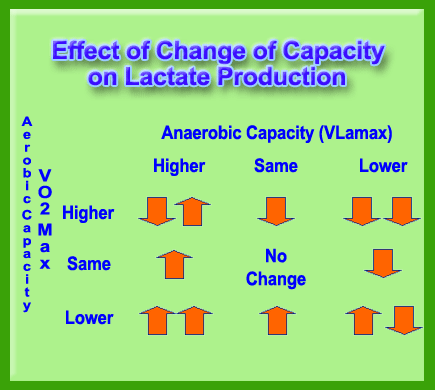Endurance Events and Lactate Testing
With Emphasis on the Triathlon
16 of 19
Training to control the
gatekeeper for aerobic energy
Implications for Training and Testing
The charts in the preceding section imply that an athlete will generate considerably less lactate at lower VLamax rates (anaerobic capacity) and, thus, fewer hydrogen ions. Lower VLamax rates mean that the muscles will be less acidic and can contract more freely at higher percentages of VO2 max(aerobic capacity.) For endurance athletes, this is highly desirable as they can race at a much higher percentage of VO2 max before generating large amounts of lactate and other metabolites, such as hydrogen ions. (lactate is not a problem; it is the metabolites that are produced when lactate is produced that interfere with contraction.)
Jan Olbrecht has found that it is possible to train these VLamax rates. Each athlete seems to have a genetic maximum and probably some lower limit. But it is not uncommon to raise or lower this parameter during a training season and thus affect lactate production and the corresponding lactate curves and an athlete's performance during an event. Many coaches do this type of training instinctively, knowing that certain workouts in specific sequences lead to better performances.
The following three charts provide insight into the differences between the measures of VO2max (aerobic system) and VLamax ( anaerobic system.) The important thing is that a coach or sports scientist cannot take their in-depth understanding of VO2 max and apply the same assumptions to VLamax. It is a very different world. First, two charts illustrate the conventional wisdom for aerobic capacity.


Source: A physiological comparison of young and older endurance athletes, G. W. Heath, J. M. Hagberg, A. A. Ehsani, and J. O. Holloszy, Journal of Applied Physiology September 1981 vol. 51 no. 3 634-640
Notice that trained is higher than untrained and younger is higher than older. Nothing unusual here. Just what one expects. If you train, your VO2 max will increase but the maximum it can reach declines with age. But here is a chart we showed earlier on anaerobic capacity. It shows something entirely different. (notice we specify anaerobic capacity as ATP production by glycolysis)

Source: Biochemistry for Medical Sciences, Newsholme, E., Leech, A.,
John Wiley 1983
There is not much published on this concept, which is why no one pays attention to it. Because it is not a research subject, it does not mean that it is unimportant. It should be a significant area of research. Notice it is the "couch potato" or untrained individual with a high anaerobic capacity, just the opposite of aerobic capacity, which is lowest in untrained individuals.
So training seems to lower anaerobic capacity. But that is a flawed conclusion, as only certain types of training lower it. There is no information here on sprinters but if there were, their values would be high, much higher than the untrained people in the above chart. The 100 m and 200 m sprinter would be extremely high and these people train intensely. Thus, certain types of training lower anaerobic capacity and other types raise it or keep it elevated.
There are genetic limits as only a few can become world-class sprinters or at the other end, world-class marathoners or Ironmen. The latter requires very high VO2max and low VLamax.
What is the proper anaerobic capacity for an athlete? That depends on the event the athlete is training for and the strength of the aerobic system. No matter what the event, more aerobic capacity is always better. However, this is far from true for anaerobic capacity. Anaerobic capacity has to be adjusted to aerobic capacity and the event.
Some typical training scenarios - For short races, it is common to manipulate the anaerobic capacity during a typical training season. For example, swimming is mostly races lasting less than two minutes. The coach will always start with endurance training at the beginning of a training season. This usually lowers anaerobic capacity and speed but increases VO2max.
As the important meets approach, the coach will switch to high-intensity workouts (often referred to as quality sets), which aim to raise the swimmers' anaerobic capacity to make them faster. Since their races are short, this increase in anaerobic capacity provides the speed to do well in these short events. But for longer races, this increase in anaerobic capacity would be detrimental. For endurance athletes, anaerobic capacity should often be lowered, but not always. Some athletes already have low anaerobic capacities, so reducing them could be self-defeating.
The relative strength of the aerobic and anaerobic systems determines substrate utilization for ATP replacement. This is the crucial point every textbook misses and because they miss it, they are inadequate in providing proper training advice. As an athlete goes through the training process, these energy systems will change depending upon the training stimulus and subsequent adaptation. This means that each system's proportion of ATP replacement will change accordingly. This is reflected in the following three principles of lactate production:
• Intensity Principle – Lactate production increases as intensity increases (within each individual athlete).
• Aerobic Capacity Principle - As aerobic capacity increases, the utilization of the anaerobic system will be less at every effort level if nothing else changes. Less lactate will be produced at each effort level.
• Anaerobic Capacity Principle – As anaerobic capacity increases, the utilization of the aerobic system will be less at every effort level if nothing else changes. More lactate will be produced at each effort level. The reverse of this is also true. As the anaerobic capacity decreases, the utilization of the aerobic system will be higher at every effort level. Less lactate will be produced at each effort level.
One of the essential implications of the last principle is that the amount of the aerobic system an athlete can access during a race depends upon the strength of the anaerobic system. The stronger the anaerobic system, the lower the percentage of aerobic capacity an athlete will reach at the maximum lactate steady state. This is one of the most important factors affecting performance for longer races. Essentially, the anaerobic system acts as a Gate Keeper for the aerobic system. It determines how much will get used. An athlete may have a huge aerobic capacity and be unable to access a lot of it because of the anaerobic capacity.
Implications for Training
Since training can affect both of these capacities in ways not always expected, it is helpful to continually monitor an athlete to assess whether training has the desired effects. The following chart indicates what can happen to lactate levels when aerobic and anaerobic capacity changes.

The chart can be read as follows. For the upper left-hand box, lactate production could go up or down at a specific effort level when anaerobic capacity rises and aerobic capacity also rises. An increase in anaerobic capacity will tend to increase lactate production, while an increase in aerobic capacity will tend to lower it. So when both of these capacities increase, the net effect could be either higher or lower lactate production. It could go up or down depending on which change had a greater effect.
When aerobic capacity goes up and anaerobic capacity goes down, the amount of lactate produced is often dramatically less. This is common with swimmers and many other athletes during base training. However, when a swimmer increases anaerobic capacity training later in the training cycle, it is pretty common to see lactate levels rise because aerobic capacity has essentially topped out for the training period. Thus, the athlete is in the middle box on the left-hand side. For an athlete such as a swimmer who is competing in short events (1-2 minutes) this is an indication that they are getting faster as their anaerobic system will be producing energy more quickly due to increased anaerobic capacity.
A note on training. Every set and workout will affect both capacities to some extent. Some more, some less. Some workouts may affect one capacity more than the other. To reach the desired balance, it may be necessary to train one capacity in the wrong direction for a short time and then counteract this effect by training it in the other direction. The reason is that it may be desirable to get one, for example aerobic capacity, to a certain level but the best way to do that it to train the anaerobic capacity either too high or too low for the event. Subsequent training might then adjust the anaerobic capacity, hopefully without affecting the aerobic capacity. Training over a season builds to an objective but constantly modifies one or both of these capacities over time to reach the desired balance.
This section is only a brief part of Alois Mader's model of energy metabolism. One of the most important contributions of this model is an explanation of how the anaerobic system affects energy metabolism and training, which was our emphasis in these three modules (Anaerobic mechanism, anaerobic gatekeeper, controlling the gatekeeper). For short races such as swimming, the model explains how an athlete can get faster while the lactate curve remains the same or even moves to the left. It also explains why most of the training for short events must be aerobic, even though the anaerobic system is the primary energy source during a fast race. For longer events, the model explains just what causes the maximum lactate steady state and what percentage of VO2 max an athlete can utilize during distance events such as the marathon, cycling road races and the triathlon. The model also explains why elite athletes, especially endurance athletes, are in more danger of over-training than lower-level athletes. Thus, they must be more careful of how intensely they train.
Some References:
Mader, A. and H. Heck (1986). "A theory of the metabolic origin of "anaerobic threshold"." International Journal of Sports Medicine 7(Sup): S45-S65.
Mader, A. (1991). "Evaluation of the endurance performance of marathon runners and theoretical analysis of test results." Journal of Sports Medicine and Physical Fitness 31(1): 1-19.
Mader, A. (2003). "Glycolysis and oxidative phosphorylation as a function of cytosolic phosphorylation state and power output of the muscle cell." European Journal of Applied Physiology 88(4-5): 317-38.
Hartmann, U., & Mader, A. (1996). The metabolic basis of rowing. In Rogozkin & R. J. Maughan (Eds.), Current research in sports science (pp. 179-185). New York: Plenum Press.
Mader, A., Hartmann, U., Hollmann, W. (1988). Der Einfluß der Ausdauer auf die 6minütige maximale anaerobe und aerobe Arbeitskapazität eines Eliteruderers. S. 62-79. In: Steinacker, J.: Rudern: Sportmedizinische und sportwissenschaftliche Aspekte. Berlin: Springer.
Mader, A., (1994). Aussagekraft der laktatieistungskurve in kombination mit anaeroben tests zur bestimmung der stoffwechselkapazität. In: Clasing, D., Weicker, H., Boening, D.: Stellenwert der Laktatbestimmung in der Leistungsdiagnostik. Stuttgart: G. Fischer.
Continue on to section 17 on consistency in testing
Module 17 of 19- The importance of consistency in testing - what you must control
